Internal migration in Scotland and the UK: trends and policy lessons
This report by the independent Expert Advisory Group on Migration and Population analyses internal migration within Scotland, and between Scotland and the rest of the UK (rUK), assessing its geographic distribution, dynamics and impacts.
2. Migration within Scotland
2.1. Classifying and measuring internal migration
We begin the discussion of migration within Scotland by looking at different ways of classifying and measuring movements within Scotland. In Scotland, movements between its 32 local authorities and its 14 health boards are classified as migration flows by the National Records of Scotland (NRS). The health board flows are based on the National Health Service Central Register (NHSCR). A record of movement is triggered when individuals change their general practitioner (GP). Data on the age and sex of the migrant are recorded, as are the origin and destination by type of area (local authority, NHS Board or SIMD (Scottish Index of Multiple Deprivation)). Because they are healthier, young people typically take longer to re-register with a doctor and therefore data on their movements may be delayed or not registered at all if they move again before they require to see a doctor. This is likely to be more of a problem with men than women, since young men are even less likely than young women to visit a doctor. Short-term migration is generally difficult to calibrate accurately.
A further complicating factor is that, on average, the number of moves recorded by the NRS between health boards is only around 70% of the moves between local authorities. This suggests that 30% of moves between local authorities are within the same health board. Not all of these moves would be classified as migration: they do not all involve substantial changes in social and economic circumstances.
Some moves between Scottish local authorities, say between Dumfries and Orkney, will inevitably disrupt individuals’ social circumstances. In contrast, a movement from Glasgow City to East Dunbartonshire may simply reflect a decision to change housing conditions, leaving the household’s circumstances, such as their job(s), otherwise unchanged. It is important to understand that measures of the volume and characteristics of internal migration are dependent on the choice of administrative boundaries used to define movements by individuals and households.
We present two new analyses of internal movement within Scotland which examine these issues. First, we use detailed data from the 2011 Census to provide an accurate estimate of distances moved in Scotland by those who changed address a year prior to census. We find that most moves are relatively short distance. Second, we reinforce this finding by using Scottish Household Survey data to show that most changes of residence within Scotland are over short distances.
The 2011 Census measures flows between “Output Areas” during the year before the census. Individuals are asked for the address at which they lived a year ago. Those who have moved are asked for their previous address and this is assigned to an Output Area. There are more than 46,000 Output Areas in Scotland. On average, each has a population of just over 1,000. The distance moved between any pair of areas can be accurately estimated using the geographic centroids of each output area. The 2011 Census recorded more than 300,000 moves between output areas. The distribution of distances moved is shown in Figure 2.1. It is dominated by short distance moves.
Of those who moved, more than 50% moved less than 5 miles and 70% moved less than 10 miles. Some of these moves will have crossed local authority boundaries and are therefore included in estimates of migration between Scottish local authorities. However, the disruption to households making the short moves are less likely to involve substantial changes in circumstances than those associated with longer moves.
Second, we looked at the Scottish Household Survey (SHS) which asks a proportion of its respondents “Have you ever lived anywhere else?[2]”. It then asks for the address of their previous residence and approximately how far away it was. This provides an estimate of the distance of the respondent’s last move. Aggregating SHS data from 2016 and 2017, responses to this question confirm the Census result that most people move short distances, although in this case the question relates to whether respondents have ever moved, rather than whether they moved in the last year.
The SHS data also include those who have never moved. This group accounts for around 10% of respondents, while those who have moved less than 5 miles account for a further 57% of the population (Figure 2.2). Most Scots either never move, or their last move has been less than 5 miles: such moves are much less likely to disrupt individual or household circumstances than moves, say, of 50 miles or more. The Census and the SHS provide a consistent message: most changes of residence in Scotland occur over very short distances and are associated with housing choice, rather than with significant changes to economic and social circumstances. The finding that most moves are short-distance is consistent with patterns observed in many high-income countries.
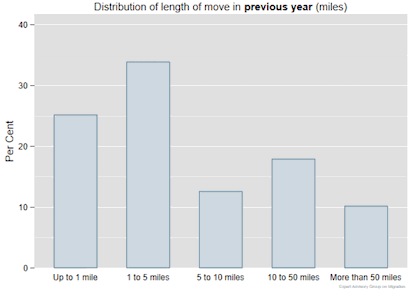
Source: Census 2011
The distinction between short and long-distance moves needs to be born in mind when analysing data on internal migration within Scotland. In their analysis of UK interregional migration flows between 1960 and 1991, Gordon and Molho (1998) estimate a cut-off between “national” and “regional” migration streams at 73 miles. They find that short distance moves are relatively unaffected by economic circumstances, while longer distance moves respond to differences in economic circumstances at the origin and the destination. This conclusion is interesting from a policy perspective. If longer moves are associated with improving the functioning of the economy, then governments should seek to reduce barriers to such moves relative to short distance moves. Policies addressing such barriers include providing easier access to the housing market for long-distance migrants such as reduced LBTT on longer moves, and measures that reduce the bureaucratic and social costs of relocation.
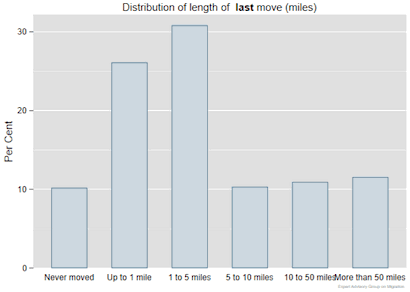
Source: Scottish Household Survey 2016-2017
Figure 2.3 shows how Glasgow’s TTWA grew between the 2001 and 2011 censuses. Parts of North Lanarkshire, East Dunbartonshire and North Ayrshire became part of the Glasgow TTWA over this period. A change in one’s doctor from a Glasgow City practice to any of the practices in these other local authorities is classed as migration by the NRS. Yet many of these moves are within the Glasgow TTWA: many of these moves recorded as migration may not have involved a change of job. The growth of the Glasgow TTWA in recent years suggests that an increasing population of workers are commuting rather than moving home. As already indicated, this may be caused by a reduction in the cost of commuting relative to housing costs. Again, this is an area of possible policy intervention: although the Scottish Parliament does not have power over the taxation of vehicles and fuel, it does have the power to introduce charges and restrictions on vehicles as well as almost complete control over housing and planning.
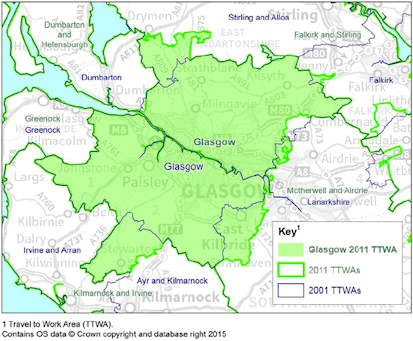
Source: Office for National Statistics
2.2 Movement between Local Authorities and Health Boards
The previous section showed that measures of migration between Scottish local authorities include some moves over short distances that reflect changing preferences and constraints in the housing market, rather than decisions that involve significant changes to both labour market and social circumstances. This makes it questionable whether these short distance moves should be described as migration. The housing market and commuting opportunities have likely been important factors in driving the growth of population in local authorities close to major cities such as Aberdeenshire, West Lothian, Midlothian and East Lothian, East and West Dunbartonshire and East Ayrshire.
Migration data based on health boards partially circumvents this issue since their boundaries tend to include both a major centre of population and surrounding commuter towns. Figure 2.4 offers some reassurance that there is a consistent relationship between migration measured at the local authority and the health board levels. This graph shows the aggregate level of gross migration flows (the sum of inflows and outflows) in health boards on the one hand, and local authorities on the other.
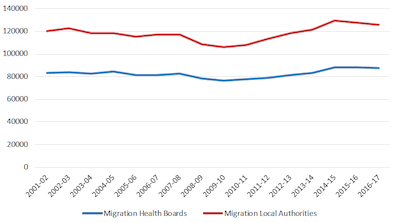
Source: National Health Service Central Register
As one might expect, gross migration flows between health boards are significantly less than those recorded between local authorities. The ratio of total flows between health boards to those between local authorities has stayed at around 70 % since the beginning of the century, suggesting that, at least over this period, the relationship between these two measures of internal migration in Scotland has been fairly stable. The remaining 30% of moves must occur within health board areas and much of these will be short distance moves between adjacent local authorities. Even so, around 80,000 people, or 1.5% of the Scottish population, move across health board boundaries each year.
This finding confirms that, while measures of migration between local authorities may overstate the true level of migration as conventionally defined, they bear a reasonably stable relationship to “true” migration levels at least since the turn of the century. Nevertheless, it will be important to bear this finding in mind for the penultimate section, in which we discuss local authority initiatives to alter migration patterns. Local authority policies aimed at attracting public sector workers from elsewhere may not lead to an overall benefit to Scotland if they simply result in movements between adjacent authorities.
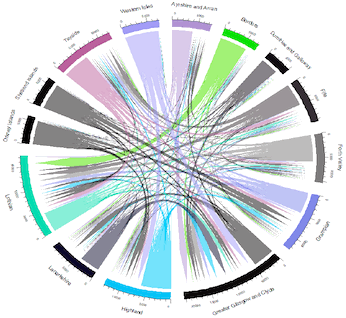
Source: National Health Service Central Register
Migration flows between health boards within Scotland are shown in Figure 2.5. The analysis focuses on health boards rather than local authorities, in order to capture longer distance migration. The figure shows migrant flows between each pair of health boards, adjusted for population size at the origin. The relative size and direction of flows is indicated by the width and direction of the arrows. Lothian and Greater Glasgow and Clyde have the widest bases because they experience the largest inflow and outflow of migrants per 1000 population.
The figure reveals some long-standing population flows that may be driven by geography and transport links such as the long-standing connection between Grampian and the Northern Isles, links between Borders and Lothian, and so on. But Greater Glasgow and Lothian draw significantly from almost all other health boards – this is perhaps a reflection of student flows into Glasgow and Edinburgh from across the rest of Scotland, which are also highlighted in Figure 2.6.
Figure 2.5 suggests that Scotland’s largest cities are focal points for migration, in respect both of inflows and outflows. Figure 2.6 demonstrates how this effect combines with the observation that migrants are typically young. It shows what used to be known as the “population pyramid” for each of Scotland’s four largest cities in 2016. It also includes four further population pyramids, for a group of Scotland’s other local authorities - East Ayrshire, Dumfries and Galloway, Borders and the Western Isles.
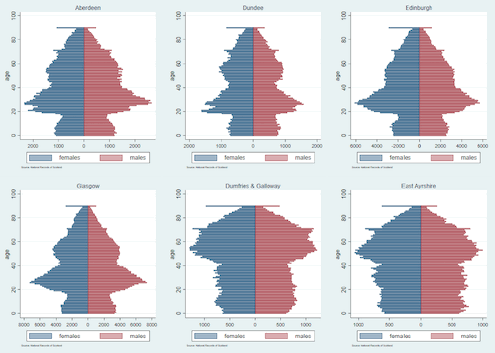
Source: National Records of Scotland
Not only do Scotland’s cities receive a substantial proportion of young people from other parts of the country, they also benefit from considerable inflows, also of young people, from the rest of the UK.
Figure 2.7 shows the proportion of students from outwith Scotland studying at Scotland’s Higher Education (HE) institutions in 2017-18. They comprised almost 32,000 students who were domiciled in other parts of the UK. Clearly this is larger than current levels of net migration to Scotland, but many of these students will return to rUK once their studies are complete. It is only those who choose to remain who make a long-term impact on net migration to Scotland.
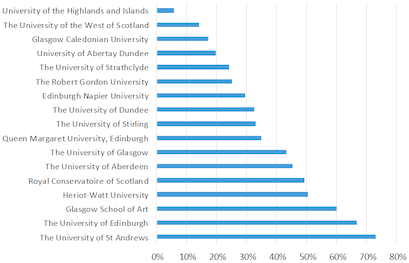
Source: Higher Education Statistics Authority
These findings imply that Scotland’s major cities are attractive both to young people from within and from outside Scotland. Migrant inflows therefore inflate the population that is brought up within these cities. This is shown in
Figure 2.8, which uses the 2018 NRS population mid-year estimates for Scotland by age group and local authority. It demonstrates that the population aged between 21 and 25 in the major cities substantially exceeds the school age population (aged 11-15) in Glasgow, Edinburgh and Aberdeen and Dundee. These cities are therefore gaining young people both from the rest of Scotland, the rest of the UK and the rest of the world due to the educational and employment opportunities that they offer: siting major educational institutions in the large cities obviously has externalities for Scotland’s smaller urban and rural areas. This is an important observation for understanding how economic activity is distributed within Scotland. It also opens the vexed question of whether economic development effort should reinforce or counteract the drift to the cities.
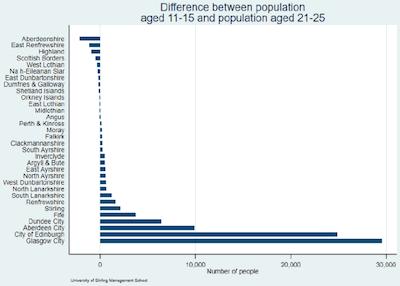
Source: Own Calculations from National Records of Scotland Data
Yet another way to classify migration is by the six-fold urban/rural split used by the Scottish Government. In-migration and outmigration rates per 1000 population are shown in Figure 2.9 for the six-fold urban-rural split. The population of these areas differs widely. The 2018 NRS population estimates suggest that large urban areas account for 35% of the Scottish population, while other urban areas account for a further 36%. In contrast, the accessible rural and remote rural only comprise 11% and 6% of the population respectively. Thus, although the rates of immigration and emigration for the large urban areas are lower than those of the accessible rural areas, the large urban areas averaged a net inflow of 11,500 people annually over the period 2010-11 to 2017-18, compared with an average net 4,800 moving to accessible rural locations.
Nevertheless, Figure 2.9 illustrates that Scotland’s “Other Urban Areas” have relatively low rates of immigration and outmigration of population compared with other area types. Other Urban Areas comprise towns, mainly in the Central Belt, which typically do not have major universities and have lost industries that were central to their economies during the last few decades. Low rates of immigration and outmigration may indicate relatively sluggish economic performance, though further research would be needed to establish this more rigorously.
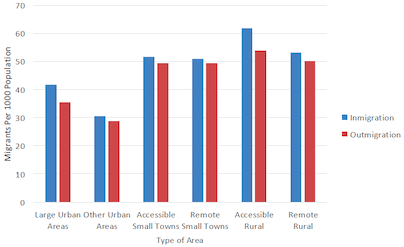
Source: National Records of Scotland
Who are the people who move within Scotland? Previous analysis showed that the majority of movers are young adults. What are the other individuals’ characteristics that are associated with elevated spatial mobility? We investigated the probability of moving within Scotland using the 2011 census microdata. We distinguished between short-distance or local moves (≤ 9 km) and between medium- or long-distance moves (> 9 km). Almost 70% of the moves were local moves according to the used definition; this finding is consistent with our previous analysis (see Figures 2.1 and 2.2). There is a clear age-pattern in the probability of moving within Scotland. The likelihood of moving is the highest in late teens and in twenties, and it significantly declines over age, as expected (Figure 2.10). Interestingly, the likelihood of moving locally is somewhat lower among those in ages 16-19; however, their relatively low local mobility is compensated by their high migration propensity: most of them move over longer distances for further education or for job-related reasons. There are no significant gender differences in the likelihood of moving.
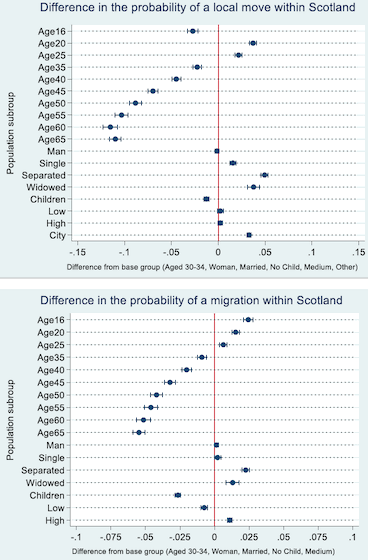
Source: The 2011 census microdata (5% sample).
Unmarried groups, especially separated and widowed individuals, are more likely to move than married individuals, particularly over short distances. Most of these moves are related to major life events (i.e. divorce or the death of a partner), although previous studies have shown that separated people are also more mobile because of residential instability and housing insecurity after separation. Couples with children are less likely to move long distance because of the increased economic and psychological costs of moving family and adjusting to a new social environment, especially when children are of school age. In terms of education, there is little difference in the likelihood of moving locally, whereas a clear educational gradient exists in migration patterns: the highly educated (i.e. individuals with a degree) are more likely to move long distance than other groups. Some of these moves may be related to the end of studies; other important factors are wider options and resources due to higher education, and a wider dispersion of jobs for highly educated people (Kulu 2008).
Finally, the analysis shows that individuals who live in the four main Scottish cities (Glasgow, Edinburgh, Aberdeen and Dundee) are more likely to move locally than those living elsewhere in the country. Some elevated mobility observed in the cities may result from the moves from neighbouring local authorities to the city centres (the census microdata contain only information on the current location of movers). However, research shows that people who live in big cities are less likely to leave the cities than residents living elsewhere; they move locally instead (Kulu 2008). Overall, short-distance moves in Scotland are mostly driven by partnership and family changes, whereas long-distance moves are related to education and employment opportunities, although this distinction is never clear cut.
Contact
Email: population@gov.scot
There is a problem
Thanks for your feedback